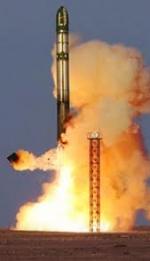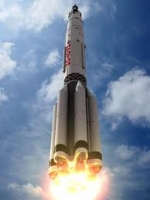Displaying items by tag: Russia
United Rocket and Space Corporation (URSC)
The United Rocket and Space Corporation is a Russian joint-stock corporation formed by the Russian government in 2013 to renationalize the Russian space sector.
The government intends to do so in such a way as to "preserve and enhance the Roscosmos space agency". The reorganization has continued into 2014.
Yasny Cosmodrome (Dombarovski base)
The Yasny launch base is located in Orenburg Region, Russia.
The base is composed of the following facilities:
- Admin & Hotel Complex including hotels, dining facilities and office premises;
- Assembly, Integration and Test Building (AITB) incorporating clean room facilities and fueling station;
- Block house on the launch pad for payload pre-launch health status control (hosts customer's personnel and equipment);
- Necessary utilities supporting the launch base operations.
The Yasny launch base is located next to the Dombarovsky air base. Dombarovsky is an interceptor aircraft base in Orenburg Oblast, Russia, located 6 km northwest of the village of Dombarovsky, near Yasny. Dombarovsky was built during the mid-60s as a Soviet ICBM bases.
Plesetsk Cosmodrome
Plesetsk Cosmodrome (Russian: Космодром «Плесецк») is a Russian spaceport, located in Arkhangelsk Oblast, about 800 km north of Moscow and approximately 200 km south of Arkhangelsk.
Plesetsk is used especially for military satellites placed into high inclination and polar orbits since the range for falling debris is clear to the north which is largely uninhabited Arctic and polar terrain. It is situated in a region of taiga, or flat terrain with boreal pine forests. The Soyuz rocket, Cosmos-3M, Rockot, and Tsyklon are launched from the Plesetsk Cosmodrome. The heavy Proton and Zenit rockets can only be land-launched from Baikonur (Zenit may also be launched at sea).
Proton (rocket)
Proton (Прото́н) (formal designation: UR-500) is an expendable launch system used for both commercial and Russian government space launches.
The first Proton rocket was launched in 1965 and the launch system is still in use as of 2012, which makes it one of the most successful heavy boosters in the history of spaceflight. All Protons are built at the Khrunichev plant in Moscow, and then transported for launch to the Baikonur Cosmodrome, where they are brought to the launch pad horizontally and then raised into vertical position for launch.
The launch capacity to low Earth orbit is about 22 tonnes. The geostationary transfer capacity is about 5–6 tonnes.
The commercial launches are marketed by International Launch Services (ILS). In a typical launch of a commercial communications satellite destined for geostationary orbit, a Proton M/Briz-M can place a spacecraft with mass at separation of 4,140 kg into an orbit with an apogee of 35,786 kilometres, a perigee of 6,257 kilometres and an inclination of 19.7°.
Like many Soviet boosters, the names of recurring payloads became associated with their launchers. Thus the moniker "Proton" originates from a series of large scientific Proton satellites, which were among the rocket's first payloads.
RSC Energia
OAO RSC Energia is a Russian manufacturer of spacecraft and space station components. The company is the prime developer and contractor of the Russian manned spaceflight program ; it also owns a majority of Sea Launch.
OAO RSC Energia is the successor of OKB-1, TsKBEM and NPO Energia after academician S.P. Korolev.
Its name is derived from Sergei Korolyov, the first chief of its design bureau, and the Russian word for energy. Its name in full is "OAO S.P. Korolyov Rocket and Space Corporation Energia" (Russian: Ракетно-космическая корпорация "Энергия" им. С.П.Королёва Raketno-kosmicheskaya korporatsiya "Energiya" im. S.P.Korolyova), also known as RSC Energia (Ркк Энергия RKK Energiya),
Energia Launcher
Energia (Russian: Энергия, Energiya, "Energy") was a Soviet rocket that was designed by NPO Energia to serve as a heavy-lift expendable launch system as well as a booster for the Buran spacecraft.
The Energia used four strap-on boosters powered by a four-nozzle RD-170 engine burning with kerosene/LOX, and a central core stage with 4 one-chamber RD-0120 (11D122) engines fueled with liquid hydrogen/LOX.
The launch system had two functionally different operational variants: Energia-Polyus, the initial test configuration, in which the Polyus system was used as a final stage to put the payload into orbit, and Energia-Buran, in which the Buran spacecraft was the payload and the source of the orbit insertion impulse.
The rocket had the capacity to place about 100 metric tons in Low Earth orbit, up to 20 t to the geostationary orbit and up to 32 t to the lunar mission trajectory.





